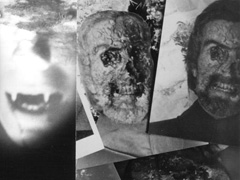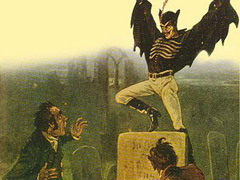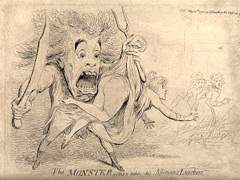


Jack the Ripper
The story of Jack the Ripper is by far the most famous mystery of them all. In 1888 five prostitutes from Whitechapel, all of whom were friends, were murdered by having their throats cut. Some of their internal organs were subsequently removed with great precision, leading detectives to believe the perpetrator must have been someone with advanced surgical knowledge. There have been plenty of suspects over the years but no conclusive proof has ever been found. Some of the most far-fetched theories involve Queen Victoria’s surgeon, her grandson Prince Albert Victor, who it was rumoured had fathered a child with one of the working women, and artist Walter Sickert, famously accused by crime writer Patricia Cornwell in 2001.
The Highgate Vampire
In the late 1960s there were reports of a tall, dark figure hovering above the grounds of Highgate Cemetery, leading passers-by to believe it was a ghost. Two men in particular, David Farrant and Sean Manchester, set about investigating the goings-on at Highgate Park, albeit independently. Both claimed to be experts in esoteric matters, and managed to drum up enough publicity to create a rivalry via the press, each alleging to have the most authority on the subject.
As it turned out there had been sightings here since Victorian times (it’s a densely wooded park with a cemetery, so go figure) however some of the older accounts described vampires rather than ghosts. In ‘Dracula’ Bram Stoker mentions Highgate Cemetery, possibly inspired by these reports. Farrant and Manchester stated they had seen dead foxes which appeared to have been drained of blood, with no injury other than a cut to the throat. In any case no one ever found any evidence of there being a vampire in Highgate, and witnesses rarely coincided with their descriptions. In 1974, Farrant was arrested in the park for vandalism, which he tried to blame on Satanists. \n\nUnderground Mysteries
There have been countless ghostly apparitions on the underground ever since its inception 150 years ago. Planners hadn’t taken into account the many plague pits they would encounter below ground, which had been dug in the 17th century as deep as possible to prevent the plague from spreading. Among the more common sightings are that of an actress around the now disused Aldwych Station, and that of actor William Terriss in the tunnels of Covent Garden station, who was stabbed by the Adelphi Theatre in 1897.
Spring-heeled Jack
Spring-heeled Jack was a household name in the 1830s. According to sources, he could breathe fire and had metallic claws, had super-human strength and was able to jump several feet into the air; the penny dreadfuls described him as being part devil part human. His prey of choice were young women, who he attacked at night, and he had no fixed stomping ground, appearing anywhere from Hammersmith to Limehouse. For the next two decades Spring-heeled Jack frequently popped up in the press, and many unresolved crimes were attributed to him. He has never been identified, however one theory is that he was played by a group of hilarious aristocrats who bet they could create panic in the city.
\n\nThe London Monster
Much like Spring-heeled Jack, the London Monster had a penchant for attractive young females, however he had a specific fetish: his approach was to stab the ladies’ derrierres with sharp objects such as knives or needles, therefore the injuries he inflicted were not usually serious. The press took great delight in sensationalising the attacker, leading to mass hysteria and many unconfirmed “sightings”, particularly once word got out of the Monster’s predilection for the pretty girls, leading to some women to allege they had been his victims to get sympathy from the public. Although Rhynwick Williams was charged with the offences in 1790 (he had tried to stab his fiancée), historians have since questioned whether he was involved in any of the attacks at all.
The Noses of Soho
Before Banksy there was Rick Buckley, an artist who protested the increase in CCTV cameras and the rise of the Orwellian state. In 1997 he made 35 replicas of his own nose and stuck them under cameras on landmarks like the National Gallery, the Tate Modern and Covent Garden Piazza, waiting to see how long it took before they were found. Some of the noses were discovered and removed immediately, but six remain in Soho to this day. Before Buckley revealed himself as being responsible for the noses all manner of rumours abounded, such as that if you found all Seven Noses of Soho you’d find great wealth, and even more incongruously that the nose on Admiralty Arch was modelled on Napoleon’s, and troops could tamper with it to boost their morale as they marched past.


